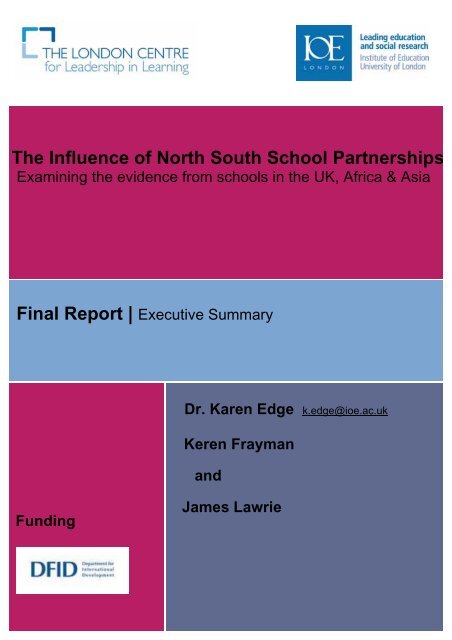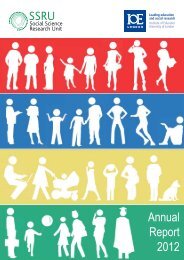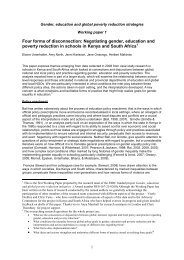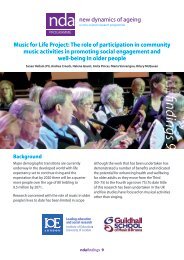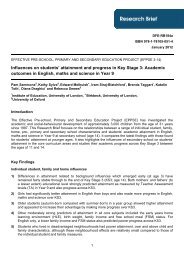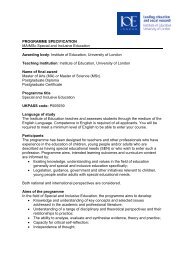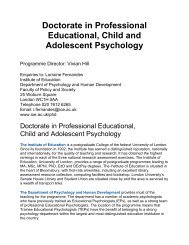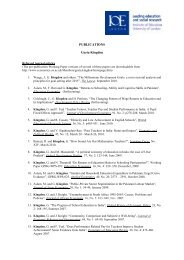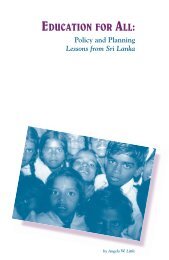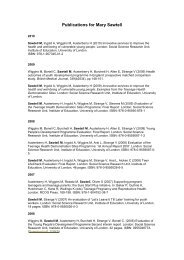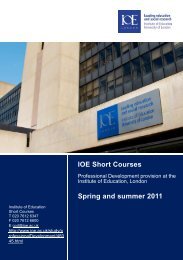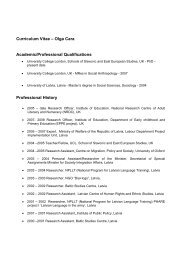Executive Summary (pdf) - Institute of Education, University of London
Executive Summary (pdf) - Institute of Education, University of London
Executive Summary (pdf) - Institute of Education, University of London
You also want an ePaper? Increase the reach of your titles
YUMPU automatically turns print PDFs into web optimized ePapers that Google loves.
The Influence <strong>of</strong> North South School Partnerships<br />
Examining the evidence from schools in the UK, Africa & Asia<br />
Final Report | <strong>Executive</strong> <strong>Summary</strong><br />
Dr. Karen Edge k.edge@ioe.ac.uk<br />
Keren Frayman<br />
and<br />
Funding<br />
James Lawrie<br />
Funding:
A NOTE FROM THE MANAGEMENT GROUP<br />
As education systems continue to evolve worldwide in order to provide a twenty-first<br />
century education for our learners, so too do the means <strong>of</strong> delivery similarly evolve in<br />
order to meet the constantly changing and increasingly complex needs <strong>of</strong> the<br />
students.<br />
One <strong>of</strong> the emerging requirements for schools in the UK is to manage the demands<br />
<strong>of</strong> globalisation. In particular they need to develop in our learners the social skills and<br />
awareness <strong>of</strong> difference so that they can engage in effective inter-cultural dialogue<br />
both internationally and in their own communities and be equipped to work in a global<br />
environment. School partnerships can be an innovative and effective vehicle for<br />
delivering global education.<br />
In order to prepare a skilled workforce for a global economy an international strategy<br />
“Putting the World into World Class <strong>Education</strong>” was launched by the then<br />
Department for <strong>Education</strong> and Skills (2004). It declared that every school and college<br />
in England and Wales should have, by 2010, a partnership with a similar institution<br />
somewhere across the world. This set in motion countless school partnership<br />
initiatives, some <strong>of</strong> significant value and others that resulted in detrimental<br />
relationships with their partnership institution.<br />
We believe that unless global learning is incorporated into the everyday learning<br />
experiences <strong>of</strong> our young people through different curriculum areas, education is not<br />
going to help to bridge the cultural and economic divides that are prevalent today. As<br />
the gap between rich and poor widens within and between countries it is also starkly<br />
apparent that learners from poor backgrounds achieve less through education.<br />
Developing global citizenship through mutually beneficial school partnerships, we<br />
believe, is one way <strong>of</strong> bridging the divide and looking forward in the 21 st century.<br />
But we are also aware that partnerships do not always meet their objectives.<br />
Consequently it is vital to identify the ingredients for successful partnerships so that<br />
these can be propagated in other schools.<br />
We need to understand the impact <strong>of</strong> the partnership on teachers, learners and the<br />
wider community in schools at both ends <strong>of</strong> the partnership, and to explore what the<br />
non-UK partner schools think <strong>of</strong> their relationships with their UK partner.<br />
This research explores our questions.<br />
Angela Cook<br />
Cambridge <strong>Education</strong> Foundation<br />
Nick Maurice<br />
UKOWLA<br />
International School Partnerships<br />
<strong>Executive</strong> <strong>Summary</strong>-2
A NOTE FROM THE PRINCIPAL INVESTIGATOR<br />
Leading a multi-country research study can be an adventure at the best <strong>of</strong> times. When you are developing<br />
instruments and methods related to a relatively new topic <strong>of</strong> research interest, it becomes even more <strong>of</strong> a<br />
journey.<br />
Our first year <strong>of</strong> research was challenging, complicated and rewarding. In many ways, via our efforts to<br />
develop partnerships with our Management and Advisory Groups as well as our research and pr<strong>of</strong>essional<br />
colleagues across the countries, we have been experiencing and demonstrating the challenges and<br />
opportunities that many schools working on their own partnerships are facing. Through our research on<br />
partnerships between schools, we have learnt about the very nature <strong>of</strong> international partnership.<br />
This report marks the conclusion <strong>of</strong> our two years <strong>of</strong> study. In the first year, we conducted surveys to<br />
understand more about the landscape <strong>of</strong> partnership across schools in the African, Asia and the United<br />
Kingdom. We invited school partnership leaders to complete surveys on their perceptions <strong>of</strong> how their<br />
partnerships started, evolved and influenced (or didn’t) various outcomes within their schools. We present the<br />
data in summary form and pose some policy related questions.<br />
Here, we present the cumulative findings from our two years <strong>of</strong> research. We focus, however, on the second<br />
year findings from our 55 school-level studies across the 5 countries in Africa, 3 countries in Asia and 4<br />
countries <strong>of</strong> the UK. The data herein presents some interesting implications for organizations supporting<br />
partnerships, policy makers, practitioners and researchers!! We hope, this report will renew and continue many<br />
<strong>of</strong> the interesting debates and discussions.<br />
Finally, we would like to thank Alex Isabirye, Headteacher at Nakanyonyi Primary School in Uganda, for<br />
allowing us to visit his school during the first and second year <strong>of</strong> the research. We were introduced to Alex via<br />
Ike Garson <strong>of</strong> Oxfordshire who had heard <strong>of</strong> our research through the development education grapevine. When<br />
Ike heard we would be in Uganda, he suggested by text, even before we had ever met in person, that we visit<br />
Alex and his colleagues. We jumped at the opportunity and had an amazing day at the school.<br />
We thank Alex and colleagues because the picture on some copies <strong>of</strong> the front <strong>of</strong> this report is <strong>of</strong> the staff<br />
room at Nakanyonyi. It was deliberately built in the middle <strong>of</strong> the schoolyard so that the teachers and students<br />
could be in contact all the time. When we visited, the teachers were busy marking in the staff room but<br />
students felt no hesitation in entering and asking questions or for help. The picture, for us, symbolizes the<br />
serendipitous nature <strong>of</strong> many partnerships and <strong>of</strong> the connections and relationships that lead to partnerships.<br />
However, more importantly, it also symbolizes the value <strong>of</strong> what we can learn from each other when we are<br />
willing to <strong>of</strong>fer our connections and support or build something in a new way.<br />
We look forward to your feedback and questions on this report, so please be in touch.<br />
Dr Karen Edge<br />
<strong>Institute</strong> <strong>of</strong> <strong>Education</strong><br />
<strong>University</strong> <strong>of</strong> <strong>London</strong><br />
k.edge@ioe.ac.uk<br />
International School Partnerships<br />
<strong>Executive</strong> <strong>Summary</strong>-3
THE INFLUENCE OF NORTH SOUTH SCHOOL PARTNERSHIPS:<br />
EXAMINING THE EVIDENCE FROM SCHOOLS IN THE UK, AFRICA AND ASIA<br />
Dr. Karen Edge, Keren Frayman and James Lawrie<br />
<strong>Institute</strong> <strong>of</strong> <strong>Education</strong>, <strong>University</strong> <strong>of</strong> <strong>London</strong><br />
2009<br />
<strong>Executive</strong> <strong>Summary</strong><br />
INTRODUCTION<br />
In this report, we present the findings from the second year <strong>of</strong> our two-year international<br />
school partnerships research study funded by the Department for International Development<br />
(DfID). Our research mandate was to explore the perceived impact <strong>of</strong> these partnerships on<br />
schools, leaders, teachers and students. We were also tasked to develop a better understanding<br />
<strong>of</strong> the types <strong>of</strong> schools that were engaging in partnerships: their characteristics, and<br />
implementation and leadership strategies.<br />
As the title <strong>of</strong> the research project suggests, we were specifically interested in partnerships<br />
between the North (United Kingdom) and the South (Africa and Asia). In the North, we<br />
explored partnerships in the United Kingdom (UK), including England, Northern Ireland,<br />
Scotland and Wales. In Africa, we collected data in Ghana, Kenya, Malawi, South Africa,<br />
Tanzania, The Gambia, Uganda and Zambia. In Asia, we worked in India, Pakistan and Sri<br />
Lanka.<br />
During the first year <strong>of</strong> our research, we explored the landscape, practice and impact <strong>of</strong><br />
partnerships in the UK, Africa and Asia, using a survey designed for Partnership Coordinators<br />
in 800 UK and 800 African and Asian schools. The findings from our first year <strong>of</strong> research 1<br />
are based on responses to our survey from schools across the UK, Africa and Asia. In the<br />
second year <strong>of</strong> the study, our sample was drawn from schools located in all four countries <strong>of</strong><br />
the United Kingdom (England, Northern Ireland, Scotland and Wales), five countries in<br />
Africa (Ghana, Kenya, Uganda, South Africa and Tanzania) and three countries in Asia<br />
(India, Pakistan and Sri Lanka). Due to national and local-level challenges, our final sample<br />
included 17 pairs <strong>of</strong> schools and 55 school case studies.<br />
We recognise that there are many different organisations that support schools partnerships.<br />
However, our purpose in this study is not to explore the different types <strong>of</strong> supporting<br />
organisations or to compare the support provided. Our primary goal is to understand more<br />
about how partnerships work and their influence on participants. We have deliberately<br />
avoided comparing programmes and approaches, and have instead rooted our work within the<br />
partnerships themselves. We hope that our findings will provide organisations working to<br />
support partnerships and schools with the evidence they require to accelerate their work.<br />
1 Copies <strong>of</strong> the first year report can be obtained by emailing Karen Edge (k.edge@ioe.ac.uk)<br />
or from the IOE, <strong>University</strong> <strong>of</strong> <strong>London</strong> website at http://www.ioe.ac.uk/lcll/current/IOE-<br />
Edge08-SchoolPartnership-Report.<strong>pdf</strong> .<br />
International School Partnerships<br />
<strong>Executive</strong> <strong>Summary</strong>-4
THE REPORT<br />
Although we have combined the findings from the first and second years <strong>of</strong> our study into this<br />
report, and highlighted the cumulative lessons from our work, we rely mostly upon the data<br />
from our second year <strong>of</strong> work. This summary follows the structure <strong>of</strong> the full report and is<br />
presented in six sections. First, we present the overarching conceptual framework that guided<br />
our work. While our primary task was to explore the influence <strong>of</strong> partnerships on the different<br />
stakeholder groups, we also wanted to understand the factors that influence those partnerships<br />
that are perceived to be moving ahead quickly with their implementation and are perceived to<br />
be having a significant influence on their leaders, teachers and students. Our methods section<br />
details how we conducted our second year research. As we have previously discussed the<br />
methods we used in our first year in other publications, we focus here on the details <strong>of</strong> how<br />
we conducted the school case studies in the second year <strong>of</strong> our research. In turn, we focus on<br />
what we have learnt about the influence <strong>of</strong> partnership on teachers and students. Within the<br />
report, we highlight our findings related to communities as well. Next, we present the distilled<br />
lessons from a set <strong>of</strong> partnerships that we believe are generating the most significant influence<br />
on their leaders, teachers and students. We have called these high momentum partnerships’<br />
and we believe that the experience <strong>of</strong> these partnerships will be <strong>of</strong> value to individuals,<br />
schools and organisations involved in partnerships. Finally, we present our conclusions and<br />
recommendations. Due to the large volume <strong>of</strong> data we collected and analysed throughout our<br />
work on this project, we have included a summary <strong>of</strong> additional resources within the<br />
Appendices that will soon be available on our website and from our research partners.<br />
THE CONCEPTUAL FRAMEWORK FOR OUR RESEARCH<br />
The complex nature <strong>of</strong> school-level work and the high number <strong>of</strong> simultaneous school-level<br />
policy interventions make it impossible to isolate how international school partnerships<br />
directly influence school- or individual-level change. However, we believe it is possible to<br />
understand how individuals view the influence <strong>of</strong> the partnership by using a range <strong>of</strong> factors<br />
associated with whole school and individual performance, learning and understanding.<br />
At the same time, simply framing this research with the question: ‘What is the impact <strong>of</strong> the<br />
international school partnership on various elements <strong>of</strong> your school and individuals?’ would<br />
have only generated a simplistic picture <strong>of</strong> how participants perceive the influence <strong>of</strong> their<br />
partnership activities on students, teachers and whole schools. We would have been unable to<br />
attribute any perceived partnership success or failure to any factors and/or conditions that<br />
exist within and between schools that support healthy and productive partnerships.<br />
There was little previous research exploring international school partnerships. As such, our<br />
conceptual model for this research is based on what we know about factors that influence<br />
successful school-level reform and partnerships, including: leadership, school effectiveness<br />
and improvement, reform implementation and partnership theory. In turn, we set about<br />
building a model that would not only allow us to examine the perceived impact <strong>of</strong> school<br />
partnerships but also to identify additional factors that may be influential. The model<br />
supported the design <strong>of</strong> the survey and analysis and provided us with three distinct sets <strong>of</strong><br />
data: inputs, in-school factors and perceived impact. Based on our reading and synthesis <strong>of</strong><br />
previous research and findings, we developed the following framework for the research.<br />
We are most interested in understanding how survey participants feel that their partnerships<br />
have impacted on their school and teaching and learning. However, without being able to<br />
make some statements about the factors that have led to that impact, our research would not<br />
have provided a robust enough picture <strong>of</strong> the partnership landscape to contribute sufficiently<br />
to the policy and practice <strong>of</strong> partnerships within the UK and beyond.<br />
International School Partnerships<br />
<strong>Executive</strong> <strong>Summary</strong>-5
Figure 1. Our conceptual framework for the NSSP research<br />
INPUTS WITHIN SCHOOL FACTORS PERCEIVED IMPACT<br />
District/LEA<br />
• District/LEA support<br />
• District/LEA ISP prioritisation<br />
• Initiation/awareness<br />
• Partnership design<br />
• Partnership activities<br />
• School demographics<br />
• Implementation<br />
P A<br />
A C<br />
R T<br />
T I<br />
N V<br />
E I<br />
R T<br />
S I<br />
H E<br />
I S<br />
P<br />
School organisation<br />
• Alignment with other initiatives<br />
• Acknowledgement in school plans<br />
• Formal evaluation/assessment<br />
• Scale <strong>of</strong> involvement<br />
Leadership<br />
• Continuity <strong>of</strong> leadership<br />
• Distributed leadership<br />
• Shared ownership<br />
• Formal role for leader <strong>of</strong> ISP<br />
• Students<br />
• Teaching and<br />
learning<br />
• Teachers<br />
• Headteachers<br />
• Pr<strong>of</strong>essional<br />
learning<br />
community<br />
• Community<br />
Partnership<br />
• Development <strong>of</strong> partnership<br />
• Negotiation <strong>of</strong> parameters<br />
• Shared goals<br />
• Ongoing development <strong>of</strong><br />
partnership<br />
• Nature <strong>of</strong> partnership activities<br />
Input factors. We gathered three types <strong>of</strong> information from survey and school case study<br />
participants. The first is the basic demographic information about each partnership school.<br />
The second is the implementation information detailing how the school became aware <strong>of</strong>,<br />
entered and designed their partnership. The third is the between and within-school<br />
partnership activities.<br />
In-school factors. Much <strong>of</strong> the research literature on school improvement and leadership<br />
suggests that changes within schools and implementation <strong>of</strong> new initiatives are more likely to<br />
occur when certain conditions are met. These conditions include prioritising the initiative,<br />
alignment with other initiatives, consistent leadership, and deep and wide embedding <strong>of</strong> the<br />
initiative within the school. To explore the possible relevance <strong>of</strong> this information for<br />
partnerships, we gathered four types <strong>of</strong> information related to factors that may influence the<br />
perceived impact <strong>of</strong> a partnership. The first is related to the support that schools receive from<br />
their district/local authority-level colleagues. The second is leadership. We were particularly<br />
interested in who is leading the partnership, the recognition <strong>of</strong> their role, how it is prioritised<br />
within the school, and the stability <strong>of</strong> leadership within the school. The third is the<br />
organisation’s characteristics. This area <strong>of</strong> inquiry should provide some information related<br />
to how schools are working to align the partnership with their other work in the school as well<br />
as other related issues. The final category related to partnerships in general<br />
Perceived impact. The end goal <strong>of</strong> this research is to assess the perceived impact <strong>of</strong><br />
international school partnerships on schools, leaders, teachers, students and communities. As<br />
previously discussed, assessing the impact <strong>of</strong> any one initiative within this very complicated<br />
and congested reform climate is nearly impossible (Anderson, 1991). Based on the model<br />
presented above, we constructed a set <strong>of</strong> measures that contribute to the success <strong>of</strong> initiatives<br />
International School Partnerships<br />
<strong>Executive</strong> <strong>Summary</strong>-6
in other contexts. As such, we developed a model that would not only gather feedback on the<br />
perceived impact <strong>of</strong> partnerships but also on the factors that influence impact.<br />
OUR METHODS<br />
The first year <strong>of</strong> our research focused on learning more about the landscape <strong>of</strong> international<br />
school partnerships between Africa, Asia and the United Kingdom. In our first year report, we<br />
detailed our process for gathering survey data from 1600 schools in 16 countries in Africa,<br />
Asia and the United Kingdom. Due to a very low response rate from Northern Ireland and<br />
Wales, the results in our first year report were based on a 21% response rate from England<br />
and Scotland, and a 59% response rate from Africa and Asia. Although these response rates<br />
represent a good first attempt at building an understanding <strong>of</strong> the reality <strong>of</strong> partnership in<br />
these regions, they are not statistically significant because <strong>of</strong> the relatively small number <strong>of</strong><br />
responses from schools in some countries. However, in combination with our second year<br />
data, we built a more robust picture <strong>of</strong> partnerships and their influence.<br />
In the second year <strong>of</strong> our research, we embarked on an ambitious journey to gather more<br />
detailed qualitative data on partnerships from 55 schools in 12 countries. We explored how<br />
schools are engaging in partnership and the perceived impact on students, teachers, schools<br />
and communities in the UK (England, Northern Ireland, Scotland and Wales), Asia (India,<br />
Pakistan and Sri Lanka) and Africa (Ghana, Kenya, South Africa, Tanzania, and Uganda).<br />
School selection. Across the sample and within each country, we were looking for schools<br />
that represented a balance <strong>of</strong> country/regions, location (urban/rural), phase<br />
(primary/secondary/all age), gender (single/mixed) and status (faith and special needs). Even<br />
though we were not comparing different partnership programmes, we wanted to ensure that<br />
different programmes were represented. Advisory Group members also recommended five<br />
schools they felt displayed what we defined as ‘interesting partnership practice’. These<br />
recommendations allowed us to have a small number <strong>of</strong> ‘recommended’ partnerships in each<br />
country, producing a stratified random sample. To maintain the anonymity <strong>of</strong> schools, we do<br />
not share their names here or anywhere in the report. However, we are in the process <strong>of</strong><br />
gaining permission to identify schools in our technical papers and school resources.<br />
Table 1: Final school/country selection breakdown<br />
Continent Country Primary Secondary All Ages Total cases<br />
Africa Ghana 1 1 1 3<br />
Kenya 2 1 1 4<br />
South Africa 3 1 0 4<br />
Tanzania 1 2 1 4<br />
Uganda 3 0 0 3<br />
Asia Pakistan 0 0 2 2<br />
India 0 0 4 4<br />
Sri Lanka 0 0 1 1<br />
UK England 6 10 1 17<br />
N. Ireland 0 3 0 3<br />
Scotland 3 1 0 4<br />
Wales 2 3 0 5<br />
Total 12 countries 21 22 11 54 (+1) 2<br />
2 We mention throughout the report that we conducted 55 school studies. We note here that one study was not<br />
included in the final write-up due to several issues related to the circumstances <strong>of</strong> the data collection.<br />
International School Partnerships<br />
<strong>Executive</strong> <strong>Summary</strong>-7
We recruited a team <strong>of</strong> international colleagues in 14 different countries. Members <strong>of</strong> our<br />
team spent one day in each participating school, conducting interviews with school and<br />
partnership leaders, leading focus groups with teachers and facilitating activity workshops<br />
with students. For each school, we have developed a 6–10 page case study outlining its own<br />
unique approach to partnership. In each case, we present information using the same<br />
categories that guided our first year survey. As such, each case study includes sections on:<br />
School background and demographic information<br />
Partnership development: formation, support, training, leadership and policy<br />
alignment<br />
Partnership in practice: objectives, communication, involvement and curriculum<br />
initiatives<br />
Monitoring and evaluation: internal and external methods <strong>of</strong> evaluation<br />
Perceived impact: students, teachers, leaders and community<br />
Challenges and opportunities: improving the partnership, advice for schools.<br />
In turn, we conducted pair-analysis <strong>of</strong> participating schools and their partners as well as<br />
continental cross-case studies to gain a better understanding <strong>of</strong> emerging trends related to the<br />
experience and impact <strong>of</strong> partnerships in Africa, Asia and the United Kingdom.<br />
Access challenges. We experienced significant challenges in recruiting schools for this<br />
research – more than we had anticipated. Within the UK, we were successful in collecting<br />
data in 28 schools. Based on our original sample, 20 <strong>of</strong> the 32 schools were eager to<br />
participate in the study. We were surprised at the challenges we faced in securing the<br />
remaining 12 schools and have identified the following reasons for their decision not to<br />
participate: partnership is no longer active; school claims to be ‘too busy’; Partnership<br />
Coordinator has left the school; change in Headteacher; and the school cannot afford the<br />
necessary supply cover. As a result <strong>of</strong> the challenges in the UK, we also faced challenges in<br />
other countries. However, when we encountered access issues in Southern countries,<br />
researchers reported security and conflict as the main issues for resistance to participation.<br />
For example, in Pakistan, resistance to participation was directly related to conflict and<br />
insecurity in the school’s vicinity. In Sri Lanka, schools were also in the midst <strong>of</strong> national and<br />
local-level crisis.<br />
Our research team. Our research explores the influence <strong>of</strong> international North-South school<br />
partnerships on schools, leaders, teachers and students. As such, we wanted our research team<br />
to echo all <strong>of</strong> these elements <strong>of</strong> our work. So while we were conducting research on<br />
partnerships, we were also developing our own partnerships with researchers around the<br />
world. We were not immune to many <strong>of</strong> the challenges our school colleagues face when<br />
building partnerships. We were actively seeking our partners, developing new relationships,<br />
communicating about important issues, and dealing with issues <strong>of</strong> funding, among many other<br />
challenges. We would like to think that, like our ‘high momentum’ partnership schools, we<br />
have turned these challenges into opportunities for learning, and that our research has gained<br />
from our collective perseverance and experience. The product <strong>of</strong> our collective efforts is<br />
presented within the summary and the full report. We hope that the research partnerships we<br />
have developed throughout our partnership research will continue in the future.<br />
Our data collection and analysis teams. The data collection teams were responsible for<br />
arranging their school visits, conducting all in-school data collection and preparing their final<br />
school-level case studies. In the United Kingdom, our data collection team consisted <strong>of</strong><br />
colleagues from the IOE, <strong>University</strong> <strong>of</strong> <strong>London</strong> including: Sonia Ben-Jaafar, Jodi Coats, Meli<br />
Glenn, Dr Rob Higham, Khatera Khamsi, Neil Gillbride, Marie Lall, James Lawrie and<br />
Victoria Showumi. We also had the pleasure <strong>of</strong> working with Elaine Lam (Bath Spa<br />
<strong>University</strong>). Our data collection and analysis colleagues in Asia include: Dr Marie Lall (IOE,<br />
International School Partnerships<br />
<strong>Executive</strong> <strong>Summary</strong>-8
<strong>University</strong> <strong>of</strong> <strong>London</strong>) and Dr Mallica Misra (Mata Sundri College for Women, India),<br />
Kulsoom Jaffar and Nil<strong>of</strong>ar Vazir (Aga Khan <strong>University</strong>, Pakistan) and Fazna Ahmad (Sri<br />
Lanka). In Africa, we worked with Viet Cooke (IOE, <strong>University</strong> <strong>of</strong> <strong>London</strong>, working in<br />
Tanzania), James Lawrie (IOE, <strong>University</strong> <strong>of</strong> <strong>London</strong>, working in Kenya), Nicanor Ogolla<br />
(Maseno <strong>University</strong>, Kenya), Connie Ssebbunga Masembe, David Kabugo and Charles<br />
Kyasanku (Makerere <strong>University</strong>, Uganda), and Everard Weber and Mathramuthu Pillay<br />
(<strong>University</strong> <strong>of</strong> the Witwatersrand, South Africa). Our analysis team was led by James Lawrie<br />
and included: Fazna Ahmed (Sri Lanka), Michael Clements (UK), Katherine Descours<br />
(Canada), Keren Frayman (Israel), Khatera Khamsi (Switzerland), Elaine Lam (UK/Canada),<br />
Heather McCuaig Edge (Canada), Shaun Phillips (UK), Bronwen Robertson (UK/New<br />
Zealand) and Melissa White (UK/Canada).<br />
Our advisory group. In addition to our extensive team <strong>of</strong> research colleagues, we had two<br />
sets <strong>of</strong> colleagues providing instrumental support. Our Management team, Angela Cook<br />
(Cambridge <strong>Education</strong> Associates) and Nick Maurice (UKOWLA and BUILD), were<br />
responsible for the finance and contracting <strong>of</strong> the project. We were fortunate to work with an<br />
excellent advisory group throughout the process. The group assisted in the definition <strong>of</strong> the<br />
research, designing <strong>of</strong> the tools and feeding back on drafts and process. These colleagues<br />
include: Shirley Addies (DFID); Angie Cook (Cambridge <strong>Education</strong> Foundation); Lynn<br />
Cutler (UKOWLA); Diana Dalton (DFID); Mary Dawson (LCD); Sandy Docherty (DFID);<br />
Bob Doe (Independent); Andy Egan (British Council-DGSP); Ann Harper (DCSF); Stephen<br />
Harvey (LCD); Judith Hemery (British Council); Andrea Mason (British Council -DGSP);<br />
Nick Maurice (UKOWLA and BUILD); Ruth Najda (British Council-DGSP); Ann Mcabe<br />
(VSO); Marie Niven (DCFS); Manisha Prajapati (DFID); Sue Schirmer (LCD); Brenda Sole<br />
(British Council -DGSP); Olga Stanojlovic (British Council); Nikki Stoddart (DFID); Helen<br />
Young (DEA); and Leena Vadler (VSO).<br />
In-school data collection. During our one day <strong>of</strong> data collection in each school, we employed<br />
four distinct data-gathering tools to support our work with leaders, teachers, other staff and<br />
community members (where possible) and students. Our UK research team designed the tools<br />
and then tested them in Uganda and, in turn, Ghana. During our visits, we conducted<br />
interviews with school and partnership leaders. We conducted a teacher focus group with<br />
those involved as well as those not directly involved with the partnership. Within each school,<br />
we conducted two student workshops to explore their experiences, knowledge and enjoyment<br />
<strong>of</strong> their partnership activities. Based on funding constraints, this data has been briefly<br />
examined but not fully analysed for inclusion here.<br />
Data analysis. We conducted our data analysis in three distinct phases. Phase one occurred at<br />
country-level and was completed by the researcher responsible for collecting the data. Based<br />
on the interviews, focus groups and observations within school, a 6–10 page case study was<br />
developed. Our international team worked across all 55 case studies to identify the emerging<br />
trends related to partnership initiation and development, leadership and management and<br />
recommendations for future development. Phase two engaged our team in conducting specific<br />
analyses that led to the development <strong>of</strong> continental and phase-based analysis. Within this<br />
strand <strong>of</strong> work, we developed the following distinct analysis summaries: UK-Primary, UK-<br />
Secondary, Africa-Primary, Africa-Secondary, Africa-All Age, and Asia-All Age. Phase<br />
three involved our team in examining the perceived influence <strong>of</strong> partnerships on teachers,<br />
students and whole schools. To explore the influence <strong>of</strong> partnerships on students, we reanalysed<br />
all 55 cases to understand more about student development <strong>of</strong> ‘knowledge’, ‘skills’<br />
and ‘understanding.’ We also focused on student enjoyment. We also wanted to know more<br />
about the influence <strong>of</strong> partnerships on teachers and explored the content, depth <strong>of</strong> skills<br />
development. We used more general analysis categories in the ‘influence on communities’<br />
section due to limited information available here.<br />
International School Partnerships<br />
<strong>Executive</strong> <strong>Summary</strong>-9
Data presentation. Throughout the remaining sections <strong>of</strong> this summary, and in the main<br />
report, we present introductory findings from our first year surveys. However, we focus our<br />
attention on the second year school case study data. The remainder <strong>of</strong> this summary focuses<br />
on three core strands <strong>of</strong> our findings: influence <strong>of</strong> partnership participation on teachers;<br />
influence <strong>of</strong> partnership participation on students; and factors contributing to high<br />
momentum partnerships. This summary concludes with recommendations for policy makers<br />
and organisations that support partnerships and schools.<br />
INFLUENCE OF PARTNERSHIP PARTICIPATION ON TEACHERS<br />
Teachers’ pr<strong>of</strong>essional development is an important part <strong>of</strong> personal and school improvement<br />
strategies. Within partnerships, teachers and leaders involved in the partnership activities<br />
consistently report learning new things as a result. Students are not the only participants who<br />
gain new knowledge, skills and understanding as a result <strong>of</strong> their partnership work. Based on<br />
our findings, teachers believe they gain a wealth <strong>of</strong> knowledge and skills from the activities.<br />
In this section we present more detailed findings from our first and second year data.<br />
Survey findings: Highlights from Year 1 report<br />
Our understanding <strong>of</strong> pr<strong>of</strong>essional learning communities and the evidence that productive<br />
pr<strong>of</strong>essional relationships between teachers can enhance their overall motivation and skills<br />
inspired our interest in exploring if partnerships influenced teachers’ relationships within<br />
schools and within partnerships. We were also partially motivated by our assumption that<br />
gathering evidence on a specific teacher’s skills and knowledge development would be<br />
difficult using a survey instrument that was being completed by the leader <strong>of</strong> the school or<br />
partnership. As such, we focused our questions on whole-school and teacher collaboration as<br />
a proxy for the conditions that traditionally inspire teachers’ development <strong>of</strong> knowledge,<br />
skills and understanding. Several key findings are summarised below; the complete findings<br />
can be found in our first year report.<br />
Teacher collaboration. In the North, 69% <strong>of</strong> schools compared to 85% <strong>of</strong> schools in the<br />
South agreed or strongly agreed that the partnerships had had a positive impact on teacher<br />
collaboration and skills development.<br />
School involvement. When reporting how they perceived their partnership’s influence on<br />
school involvement, 72% <strong>of</strong> Northern respondents and 89% <strong>of</strong> Southern respondents agreed<br />
or strongly agreed that the partnership positively influenced involvement <strong>of</strong> students,<br />
teachers, the whole school and the community around educational issues and improvement.<br />
Influence <strong>of</strong> partnerships on teachers: <strong>Summary</strong> <strong>of</strong> school case findings<br />
In this section, we summarise our findings from all school cases studies from across Africa,<br />
Asia and the UK. We describe the five core themes that emerged during our analysis,<br />
including: partnership influence on teachers’ skills; pedagogic changes; teacher’s general<br />
knowledge development; teachers’ understanding; and teachers’ enjoyment. These different<br />
elements <strong>of</strong> how partnership participation influences teachers are drawn directly from the<br />
data. It is important to reiterate that we did not rely on existing structures or theory to<br />
constrain our analysis <strong>of</strong> the data.<br />
Partnership influence on teachers’ skills. In order to explore the depth and breadth <strong>of</strong><br />
teachers’ skills development through their partnerships, we examined our data from across all<br />
55 schools to identify the skills that teachers are developing as a result <strong>of</strong> their participation in<br />
partnerships. These skills can be grouped into six categories, including: teaching skills;<br />
International School Partnerships<br />
<strong>Executive</strong> <strong>Summary</strong>-10
interpersonal skills; leadership skills; planning and management skills; creativity; and ICT<br />
skills.<br />
Partnership influence on pedagogic changes. Across our participating schools across Africa,<br />
Asia and the United Kingdom, teachers <strong>of</strong>ten pr<strong>of</strong>ess changes to their teaching practice as a<br />
result <strong>of</strong> their participation in their international school partnership. Specific pedagogical<br />
changes can be grouped into six categories, including: behaviour management; delivery <strong>of</strong><br />
lessons; greater range <strong>of</strong> resources to support learning; different teaching methods based<br />
on fewer resources; lesson planning; and other.<br />
Partnership influence on changes in pedagogy. As teachers clearly indicate, many have<br />
changed their pedagogies as a result <strong>of</strong> the partnership. Based on our conversations in<br />
schools, there are four main catalysts for changes in pedagogy, including: exchanging ideas<br />
and mutual learning between partner schools; borrowing teaching methods; reflecting on<br />
teaching and learning practice; and other.<br />
Partnership influence on teachers’ general knowledge development. As we know that pupils<br />
are learning about their partner countries, we were specifically interested in the influence <strong>of</strong><br />
the partnerships on the acquisition <strong>of</strong> knowledge by teachers. Upon reviewing all <strong>of</strong> our<br />
school case studies, we discovered that teachers’ general knowledge development can be<br />
categorised in the following four groups: global issues; their partner school’s country;<br />
school management and organisation in their partner country; and school management<br />
and organisation in their own country.<br />
Partnership influence on teachers’ understanding. During our time in schools, we asked<br />
questions <strong>of</strong> teachers and leaders about the type <strong>of</strong> skills and knowledge they were<br />
developing. However, during our analysis, information about teachers’ understanding<br />
(including understanding <strong>of</strong> different cultures) permeated elements <strong>of</strong> our school case studies.<br />
Three distinct categories <strong>of</strong> understanding emerged: differences and similarities between<br />
cultures; challenging their preconceptions and stereotypes; and developing their<br />
understanding <strong>of</strong> other cultures.<br />
Partnership influence on teachers’ enjoyment. Students enjoy their participation in<br />
partnership. We believe that the teachers’ enjoyment <strong>of</strong> partnership is an important factor in<br />
how students experience their partnership. As such, we wanted to mine the data in our case<br />
studies to explore if and how teachers are enjoying their partnership. Teachers and leaders<br />
experience the partnership, specifically in terms <strong>of</strong> their levels <strong>of</strong> enjoyment <strong>of</strong> different<br />
activities, can be categorised as follows: personal connections; learning about other<br />
cultures; management or organisation <strong>of</strong> projects or activities; learning different teaching<br />
methods; increased student learning and/or motivation; and other.<br />
INFLUENCE OF PARTNERSHIP PARTICIPATION ON STUDENTS<br />
What is the impact on students <strong>of</strong> participating in a school partnership? More specifically,<br />
what is the influence <strong>of</strong> partnerships on students’ knowledge, skills and understanding?<br />
Throughout both years <strong>of</strong> our research, we focused on learning more about the influence <strong>of</strong><br />
partnership participation on students. Based on our data, students develop knowledge, skills<br />
and understanding through their participation and this is especially true in well-developed and<br />
high momentum partnerships. The different types <strong>of</strong> knowledge, skills, understanding,<br />
enjoyment and motivation have been identified as recurring across all three regions. In the<br />
full report, we specifically describe the predominant outcomes in the particular context <strong>of</strong><br />
Africa, Asia and the United Kingdom. In the full report we also, highlight any specific issues<br />
related to the outcomes <strong>of</strong> primary, secondary and, where appropriate, all age students.<br />
International School Partnerships<br />
<strong>Executive</strong> <strong>Summary</strong>-11
However, before moving to our second year school case data, we want to review key findings<br />
from our first year survey research.<br />
Survey findings: Highlights from Year 1 report<br />
Student development and context knowledge and student outcomes. Data from the first year<br />
report shows that partnership leaders in both Northern (91%) and Southern (85%) schools<br />
perceived the partnership to have a positive influence on students’ development <strong>of</strong> content<br />
and context knowledge. In terms <strong>of</strong> student participation and engagement, 66.7% <strong>of</strong> Northern<br />
schools and 88.6% <strong>of</strong> Southern partnership leaders agreed or strongly agreed that the<br />
partnership has had a positive influence. Specifically, these findings show that in schools in<br />
the South (Africa and Asia) the partnerships seem to have more strongly influenced student<br />
outcomes, behaviour and learning than in the Northern schools.<br />
Changes in students’ academic and social behaviour. In response to their perceptions <strong>of</strong> the<br />
partnership’s influence on students’ achievements, academic and social behaviour, and<br />
learning, responses from participants in the South were twice as positive as those in the<br />
North. When reporting how they perceived their partnership’s influence on changes in their<br />
students’ academic and social behaviour, 49% <strong>of</strong> Northern schools and 85% <strong>of</strong> Southern<br />
schools agreed or strongly agreed that the partnership had had a positive influence.<br />
Influence <strong>of</strong> partnerships on students: <strong>Summary</strong> <strong>of</strong> school case findings<br />
Based on interviews with teachers and leaders, focus groups and, in some cases, analysis <strong>of</strong><br />
student activity data, there was a strong belief that partnership participation has an influence<br />
on students. It is important to note that within each theme, the different elements <strong>of</strong> how<br />
students are influenced through partnership participation are drawn directly from the data. We<br />
did not rely on existing structures or theory to constrain our analysis <strong>of</strong> the data. The five<br />
themes include: partnership influence on students’ knowledge; partnership influence on<br />
students’ skills; partnership influence on students’ understanding; partnership influence<br />
on students’ enjoyment; and partnership influence on students’ motivation.<br />
In this section we present summary findings from all case studies across Africa, Asia and the<br />
UK. Within each theme (students’ knowledge, skills, understanding, enjoyment and<br />
motivation), the different elements <strong>of</strong> how students are influenced through partnership<br />
participation are drawn directly from the data. It is important to reiterate that we did not rely<br />
on existing structures or theory to constrain our analysis <strong>of</strong> the data.<br />
Partnership influence on students’ knowledge. Looking across all case studies in all<br />
countries, we found that students <strong>of</strong>ten develop three core areas <strong>of</strong> knowledge in relation to<br />
their partnership work. While knowledge acquisition is evident to different degrees in<br />
different schools, partnerships appear to influence student learning related to knowledge <strong>of</strong><br />
the partner country; knowledge <strong>of</strong> their home country; and knowledge <strong>of</strong> global issues.<br />
Often, when discussing what they have learned about their partner country, students and<br />
teachers believe they have developed knowledge related to the climate, culture, education<br />
systems and food <strong>of</strong> their partner country. Knowledge <strong>of</strong> their own home country <strong>of</strong>ten relates<br />
to exploring their national traditions, heroes and events. Students’ knowledge <strong>of</strong> global issues<br />
<strong>of</strong>ten relates to climate change, fair trade and other issues affecting countries around the<br />
world.<br />
Partnership influence on students’ skills. When we examined our data related to students’<br />
skills development, eight distinct categories <strong>of</strong> skills emerged, including: ICT; leadership;<br />
literacy; numeracy; interpersonal; creativity; planning and management; and analytical.<br />
Any skill that fell beyond these categories was grouped in an ‘unspecified skills category’.<br />
International School Partnerships<br />
<strong>Executive</strong> <strong>Summary</strong>-12
Partnership influence on students’ understanding. We wanted to identify areas <strong>of</strong> student<br />
learning, and <strong>of</strong> specific knowledge and skills developed as a result <strong>of</strong> partnership<br />
participation. During our research, it became clear that students’ understanding – beyond<br />
knowledge and skills – is an important outcome <strong>of</strong> partnership participation. As we analysed<br />
the school cases with an eye to capturing information on students’ understanding, we found<br />
that students develop an understanding <strong>of</strong> others through exploring similarities and<br />
differences between cultures; challenging preconceptions and stereotypes; and learning<br />
about other cultures.<br />
Partnership influence on students’ enjoyment. We were interested in learning more about<br />
students’ enjoyment <strong>of</strong> partnerships and partnership-related activities. This was inspired by<br />
our belief that students who are enjoying a particular subject and/or activity are more likely to<br />
pursue their learning and develop deeper understanding. Based on our research, four<br />
categories <strong>of</strong> student enjoyment emerge from the data, including: personal connection;<br />
learning about other cultures; assistance in the management or organisation <strong>of</strong> projects or<br />
activities; and other.<br />
Partnership influence on students’ motivation. While pupils in our participating schools<br />
clearly enjoy the partnership, we were interested in exploring how partnerships may influence<br />
their motivation to learn. Although during our interviews we did not ask a direct question<br />
about whether pupils’ motivation for learning increased with the link, motivation to learn<br />
emerged consistently as an outcome <strong>of</strong> students’ partnership participation. Looking across all<br />
<strong>of</strong> our participating schools, several themes emerge from the data related to students’<br />
motivation, including: opportunities to develop personal connections; learning about other<br />
cultures; assistance in the management <strong>of</strong> projects or activities; and other. In African<br />
schools, we identified several sources <strong>of</strong> motivation: interest in global issues; financial<br />
benefit; building friendships; and learning English.<br />
FACTORS CONTRIBUTING TO HIGH MOMENTUM PARTNERSHIPS<br />
Students and teachers are clearly influenced by their participation in partnerships as<br />
evidenced by our first and second year findings. Based on our desire to know more about the<br />
types <strong>of</strong> school partnerships that were most likely to produce these sorts <strong>of</strong> outcomes, we<br />
developed a strategy for re-examining all participating pairs <strong>of</strong> schools in our study. During<br />
this process, six partnerships emerged as having strong evidence <strong>of</strong> momentum, including:<br />
mutually beneficial partnerships; enthusiasm among the majority <strong>of</strong> the school; and a<br />
commitment to maintain and support the partnership. In this section, based on our analysis<br />
<strong>of</strong> these partnerships, we present the factors and conditions we believe are necessary for well<br />
functioning and high momentum partnership.<br />
Partnership formation. In order to understand the detailed nuances <strong>of</strong> the factors that<br />
contribute to the formation <strong>of</strong> high momentum partnerships, we examined how these schools<br />
began their partnerships. We found that early exchange experiences, or exchanges during the<br />
actual initial development <strong>of</strong> the schools pairings, are more prominent in all the high<br />
momentum partnerships. Other fundamental factors to laying the foundation for high<br />
momentum partnership include: a personal connection; whole school involvement in the<br />
decision making process; a clear purpose; supportive leadership; and a support<br />
organisation’s assistance.<br />
Support and training. Well functioning, high momentum partnerships have all received some<br />
form <strong>of</strong> financial support for their partnerships. Five <strong>of</strong> the six partnerships have received<br />
core funding support from a common organisation. However, this funding comes in different<br />
formats. Most high momentum partnerships are receiving other organisation funding; local<br />
International School Partnerships<br />
<strong>Executive</strong> <strong>Summary</strong>-13
community support; local authority support, and non-governmental organisation nonfinancial<br />
support. In two <strong>of</strong> our six partnerships, two are using their own funds to maintain<br />
and support the partnership. This is particularly with respect to funding student exchanges.<br />
Our high momentum schools also highlight training as an important component <strong>of</strong> their<br />
development.<br />
Leadership and management. At the heart <strong>of</strong> each high momentum partnership is a strong<br />
and committed leadership and management structure that support and nurture partnership<br />
development. In all cases, a strong leader, active school leadership support and staff support<br />
emerge as important factors in partnership success. Another important factor, which directly<br />
relates to the extent <strong>of</strong> engagement in the partnership across the school, is the role <strong>of</strong> teacher,<br />
student or parent partnership committees, and extracurricular clubs to support the ongoing<br />
development <strong>of</strong> the partnership.<br />
Connection to school structures. Our high momentum partnerships demonstrate that their<br />
partnerships are closely tied to the overall work and priorities <strong>of</strong> the school. Also, the<br />
partnership serves to enhance the overall work <strong>of</strong> the school and, in some cases, relates<br />
directly to school improvement. One common and strategic way to ensure that partnerships<br />
are embedded within schools involves connecting it directly to the school’s development<br />
plan. In other countries, where nationally required school development plans are not part <strong>of</strong><br />
normal school practice, these schools also create links between the partnership and the school<br />
structure by including the partnership in their overall objectives. Both strategies point to the<br />
value <strong>of</strong> creating a formal and recognised strategy for positioning the partnership within the<br />
school’s priorities and plans. There are, <strong>of</strong> course, other methods for connecting partnerships<br />
to school structures in our high momentum schools, including securing cooperation from<br />
Governors and/or linking it to other significant documents and priorities within the school.<br />
Partnership objectives. All <strong>of</strong> our high momentum partnership schools are pursuing a variety<br />
<strong>of</strong> partnership objectives, which suggests that one clear, unified purpose among both partner<br />
schools is unusual. High momentum partnerships appear to design their partnership objectives<br />
to meet the overall needs <strong>of</strong> the school. It appears that our high momentum partnerships are<br />
those that are using the partnership to fulfill the true interests, ambitions and needs <strong>of</strong> the<br />
school. In addition, these partnerships have focused on any <strong>of</strong> the following objectives<br />
including: broadening horizons/global citizenship/exploring cultures; student and teacher<br />
learning; school improvement; and fundraising/charity.<br />
Communication between partners. Across all <strong>of</strong> our high momentum partnerships, schools<br />
use a variety <strong>of</strong> different communication methods. Each pair <strong>of</strong> schools uses more than one<br />
method to communicate with their partner. Telephone communication is the most prominent;<br />
however, it appears to be used as a last resort when other forms do not work. Four schools<br />
mention using both fax and email. Post and email are used by four schools. Two schools also<br />
report active text messaging. Other important communication-related lessons from our high<br />
momentum schools include: students’ emails/texts/letters; minimum monthly<br />
communication; and overcoming the limitations <strong>of</strong> a weak Internet connection.<br />
Staff and student involvement. All schools in our high momentum partnerships, except one<br />
Southern school, have participated in and endorse the value <strong>of</strong> teacher exchanges. Just as<br />
early exchanges are fundamental to the growth <strong>of</strong> a high momentum partnership, continued<br />
teacher exchanges appear to be equally as valuable. Teacher exchanges motivate and <strong>of</strong>fer<br />
pr<strong>of</strong>essional development opportunities for staff, as well as renew and refresh the important<br />
personal connections developed in the partnership. Student exchanges take place in all the<br />
partnerships in our high momentum category and appear to be important factors in motivating<br />
students to get involved in the partnership and in creating a more tangible partnership<br />
experience for them.<br />
International School Partnerships<br />
<strong>Executive</strong> <strong>Summary</strong>-14
Curriculum initiatives. There is evidence <strong>of</strong> shared curriculum initiatives within each <strong>of</strong> our<br />
high momentum partnerships. All schools include the partnership in a number <strong>of</strong> subjects,<br />
with two schools having curriculum projects in a number <strong>of</strong> subjects involving all students. In<br />
all but one school, these in-lesson activities are also combined with extracurricular wholeschool<br />
events. In addition, curriculum work across schools is supported in our high<br />
momentum partnerships by shared teaching <strong>of</strong> lessons; subject inclusion; and special<br />
events.<br />
Challenges and opportunities. Without exception, challenges arise in all partnerships. What<br />
differentiates these six partnerships from others is how they approach resolving these<br />
challenges. In all six <strong>of</strong> our high momentum partnerships, the morale <strong>of</strong> the participants and<br />
whole school community sustains their partnership success. The actual challenges are varied<br />
and include: communication; funding; commitment and time; leadership; and government<br />
involvement. However, they are seen as inconveniences, not barriers to success!<br />
CONCLUSIONS AND RECOMMENDATIONS<br />
Our adventure in researching international school partnerships has also become our own<br />
adventure in developing international research partnerships. The many months we have spent<br />
leading and facilitating this project have allowed us to build our collective knowledge about<br />
how schools can make their international school partnerships into exciting and meaningful<br />
contributors to the growth and development <strong>of</strong> both schools and individuals. We are aware<br />
that there are many different audiences for our findings. To simplify the lessons from our<br />
research and to provide the greatest access to our conclusions and recommendations, we<br />
present them below for leaders and teachers <strong>of</strong> partnership schools, for supporting<br />
organisations and for policy makers. As many <strong>of</strong> the recommendations apply, however, in<br />
slightly different ways to each group, we highly recommend that each group extend their<br />
reading beyond those recommendations specifically geared to them. In the near future, our<br />
team will be creating a resource for each group to support their usage and work with the<br />
findings.<br />
Prior to moving onto the final conclusions and recommendations, we want to highlight how<br />
the findings related to our original conceptualisation <strong>of</strong> school partnerships. The model<br />
comprised three distinct, yet overlapping categories: input factors; in-school factors; and<br />
perceived impact. This summary and the full report focus much attention on the perceived<br />
impact <strong>of</strong> partnerships in schools and on teachers, leaders and students. We have also touched<br />
on the importance <strong>of</strong> the input and school-level factors that can enhance partnership<br />
participation. These include, but are not limited to:<br />
Engaging teachers and leaders from across the school in deciding to embark on the<br />
partnership<br />
Sourcing available start up funding<br />
Creating incremental partnership development strategies that build on ongoing work<br />
Ensuring widespread teacher and student involvement in the partnership<br />
Distributing leadership <strong>of</strong> the partnership to ensure its sustainability within the school and<br />
ensuring it is manageable and attractive to teachers and leaders<br />
Embedding the partnership within the structures and planning infrastructure <strong>of</strong> the school<br />
to ensure it becomes an integral part <strong>of</strong> the work<br />
Integrating the partnership into capacity building and school improvement plans<br />
Creating an emphasis on generating supports for sustainability as a forward planning<br />
mechanism in anticipation <strong>of</strong> the discontinuation <strong>of</strong> funding.<br />
International School Partnerships<br />
<strong>Executive</strong> <strong>Summary</strong>-15
While these issues are explored in more depth within the full report and within the<br />
recommendations and conclusions, we will be creating additional resources based on these<br />
observations as well as the final conclusions and recommendations over the coming months.<br />
An additional paper mapping the findings onto our initial model will also be available to<br />
support ongoing partnership design, implementation and development.<br />
Recommendations for teachers and leaders to enhance partnership influence<br />
Based on our two years <strong>of</strong> research, we have developed a robust sense <strong>of</strong> how international<br />
school partnerships work within schools and what school leaders can do to support the<br />
development <strong>of</strong> high momentum partnerships. We would refer anyone interested in the<br />
characteristics <strong>of</strong> high momentum partnerships to our full section on the topic in the report.<br />
However, we do have some specific recommendations from the wider sets <strong>of</strong> data on how<br />
schools can make the most <strong>of</strong> their partnership. We are in the process <strong>of</strong> preparing several<br />
resources on leading partnerships for school leaders. These will provide more specific detail<br />
on the design and implementation <strong>of</strong> partnership and will be available on our website within<br />
the next few months.<br />
Based on the evidence from our research, we have identified several core themes for leaders<br />
and teachers to consider as they design and implement their partnerships. The themes,<br />
presented below, include: designing for school development and partnership<br />
implementation; building leadership for sustainability; promoting learning<br />
opportunities; and promoting intercultural dialogue and global awareness. Within each<br />
theme, we draw conclusions from our research and set out recommendations we believe will<br />
support the ongoing success <strong>of</strong> our high momentum school partnerships.<br />
Designing for school development and successful partnership implementation<br />
Nurture exchange visits for school improvement and capacity building. Pr<strong>of</strong>essional – and<br />
<strong>of</strong>ten personal – development results from direct contact with overseas colleagues. When<br />
teachers travel overseas, they reflect on their role as a teacher, learn new knowledge, skills<br />
and understanding. Often, they have life-changing experiences and bring back their learning<br />
and transformation into their classrooms. To enhance the value <strong>of</strong> exchanges, we recommend<br />
that school-based partnership leaders and teachers:<br />
use their partnership as a vehicle for advancing a culture <strong>of</strong> staff learning and positive<br />
attitudes towards personal and pr<strong>of</strong>essional development<br />
consider how an individual’s experience as participant in an international school<br />
partnership can contribute to changes within the school, its strategies and follow through<br />
so they can share their experience in a safe and positive way to contribute to the overall<br />
learning <strong>of</strong> all teachers<br />
encourage staff exchange participation among those who would benefit from developing<br />
confidence, and leadership and communication skills<br />
harness the observations <strong>of</strong> other schools’ strategies and structures to reflect on internal<br />
school issues, including behaviour management and teacher–student relationships within<br />
their school<br />
build opportunities for pr<strong>of</strong>essional development into exchanges by encouraging all<br />
travelling members <strong>of</strong> the partnership to teach in each other’s schools as a means <strong>of</strong><br />
initiating and developing pr<strong>of</strong>essional capacity and student learning.<br />
Start with meaningful units <strong>of</strong> partnership. Building sustainable educational change,<br />
including partnership, is a challenging endeavour. We also know that all educational changes<br />
start with a small group <strong>of</strong> impassioned supporters. Based on our evidence, as well as the<br />
larger body <strong>of</strong> educational change theory, we believe that partnerships may be stronger when<br />
International School Partnerships<br />
<strong>Executive</strong> <strong>Summary</strong>-16
they are initiated by a small group <strong>of</strong> individuals. In secondary schools, this could take the<br />
form <strong>of</strong> a linked department – English or Geography, for example – rather than the whole<br />
school. This would concentrate resources, ensure suitable teachers from both schools are<br />
initially linked and provide a focus for activities within both schools. Thus the objective <strong>of</strong><br />
the partnership is clear and focused, its scope is narrow, and there is a greater likelihood that<br />
it will be linked to the curriculum. The partnership could, over time, grow to include a greater<br />
number <strong>of</strong> staff and possibly become a whole-school endeavour.<br />
Building leadership for sustainability<br />
Develop leaders (and the partnership) by distributing leadership. The role <strong>of</strong> the Partnership<br />
Coordinator(s) within a school is far from straightforward. However, being a Partnership<br />
Leader is an excellent opportunity for teachers and leaders to deepen their skills as is leading<br />
the partnership by embedding an initiative, incenting school-wide collaboration and<br />
generating staff buy-in. Furthermore, visiting an overseas partner enables individuals to<br />
observe and learn about school leadership in a different context. In order to foster interest in<br />
the partnership and broaden the number <strong>of</strong> individual champions within the school, we<br />
recommend that leaders be encouraged to ensure that there are multiple leaders that can take<br />
on responsibility if the initial Partnership Leader moves on to another school.<br />
Promoting learning opportunities<br />
Organise partnership activities within and beyond the curriculum. Partnerships provide an<br />
avenue for teachers and students to gain knowledge about their partner countries. They also<br />
create opportunities for examination <strong>of</strong> comparative and local issues related to the countries<br />
and regions involved. Issues can be explored through the curriculum and linked to specific<br />
national curriculum objectives. Equally importantly, knowledge can be nurtured through<br />
informal activities such as assemblies, discussion with visiting teachers and whole-school<br />
events. We recommend that schools use the partnership in a variety <strong>of</strong> forums to facilitate the<br />
widest possible access to opportunities for teachers and students to develop their knowledge<br />
and awareness <strong>of</strong> issues related to their partnership and global issues.<br />
Promote interactions to develop skills. Our findings show that teachers and students are more<br />
likely to develop skills when they are interacting directly with others from their partner<br />
schools or their partner school country. We recommend that schools work at generating<br />
multiple opportunities for person-to-person interaction, whether in everyday lessons or<br />
through special clubs or events, to support the development <strong>of</strong> skills such as literacy,<br />
interpersonal and ICT.<br />
Promoting intercultural dialogue and global awareness<br />
Encourage visits from partner school to develop student’s understanding. Hosting teachers<br />
from a partner school has a greater influence on students’ understanding <strong>of</strong> others (in terms <strong>of</strong><br />
breaking down stereotypes, understanding other cultures and so on) than having their teacher<br />
visit a partner school. This is because students have direct contact with the visitors, rather<br />
than simply receiving feedback from their own teachers. We recommend that policy and<br />
programmes should ensure visits are balanced, with a similar numbers <strong>of</strong> staff and, in some<br />
cases students, going in each direction.<br />
Coordinate opportunities for participants to deliberately engage in challenging stereotypes.<br />
When interactions between teachers and students and their colleagues from their partner<br />
schools are facilitated to support the sharing <strong>of</strong> perspectives on global issues and exploring <strong>of</strong><br />
stereotypes, students develop a richer understanding <strong>of</strong> the global context and their role in the<br />
world. In some cases, stereotypes are challenged which may lead to a deeper level <strong>of</strong> cultural<br />
International School Partnerships<br />
<strong>Executive</strong> <strong>Summary</strong>-17
sensitivity. By identifying preconceptions among students, teachers may be able to challenge<br />
these directly by designing activities that provide them with information about the other<br />
country. Pupils should be encouraged to ask partner pupils questions about their culture.<br />
Through interest and inquiry, pupils are <strong>of</strong>ten able to develop a stronger understanding <strong>of</strong> the<br />
other culture and process new information that will help them challenge stereotypes. There is<br />
some evidence that remote communication has supported this learning, but evidence from the<br />
case studies indicates that face-to-face meetings have a significantly greater impact. We<br />
recommend that leaders and teachers create these opportunities for their students and<br />
colleagues at all stages <strong>of</strong> partnership development.<br />
Foster development <strong>of</strong> global knowledge and awareness. Partnerships enable both those<br />
directly and indirectly involved to develop knowledge about the partner country, its education<br />
systems and global issues. Whole-school learning and development is particularly influenced<br />
by high pr<strong>of</strong>ile events. We recommend that UK schools consider how their partnerships can<br />
be used to deliver cross-curricular themes with a strong emphasis on developing the Global<br />
Dimension.<br />
Facilitate student-to-student collaborations. An international school partnership can be a<br />
launch pad for students to develop a greater interest in global issues and other cultures. The<br />
key feature <strong>of</strong> UK partnership schools that motivates students is the opportunity for them to<br />
develop a personal connection with their counterparts in other countries. In African and Asian<br />
schools, partnership activities mostly take place in the classroom. In these countries, the more<br />
socially motivated outcomes such as building relationships with students overseas and<br />
communicating with tourists may not be seen to be as important as the traditional academic<br />
motivation to achieve higher grades. However, for UK students, the personal connection is an<br />
important aspect <strong>of</strong> their personal growth and development. It appears that students become<br />
motivated and enthusiastic about learning based on their friendships with partner pupils. We<br />
recommend schools place an emphasis on fostering connections between students as this will<br />
likely lead to a greater interest in global issues. However (as we are sure all educators in<br />
partnerships currently do) we emphasise that the issue <strong>of</strong> student protection is given high<br />
priority and monitored throughout activities.<br />
Conclusions and recommendations for supporting organisations<br />
Based on our findings, several simple suggestions have emerged. We encourage support<br />
organisations to consider carefully those elements <strong>of</strong> the recommendations for schools above<br />
as this could enhance their current work process. We are, as previously stated, developing a<br />
resource tool for support organisations based on our findings to provide an evidence-based<br />
guide for supporting and nurturing high momentum partnership. We believe that support<br />
organisations have a key role to play in ensuring partnerships are meaningful to all<br />
participants. The following should be prioritised:<br />
Ensuring programmes are building on current evidence. Across the UK and around the<br />
world, there is little research evidence on what makes a successful partnership in terms <strong>of</strong><br />
meaningful teaching and learning. This research, thanks to the funding from DFID and the<br />
support <strong>of</strong> our Advisory Group partners and international research team, makes a<br />
considerable contribution to what is known about high momentum partnerships. However,<br />
others in the UK are working on the issues and more evidence will be coming to light in the<br />
next year. We recommend that support organisations and policy makers both draw on the<br />
evidence when designing and supporting international partnerships, and ensuring that schools<br />
have access and the opportunity to read, debate and reflect on the evidence and its<br />
implications for their own work.<br />
International School Partnerships<br />
<strong>Executive</strong> <strong>Summary</strong>-18
Supporting multimodal communication and engagement between partners. Our evidence<br />
suggests that high momentum partnerships use different forms <strong>of</strong> communication to engage<br />
with their partners. We recommend that support organisations ensure that their schools are<br />
encouraged to work in this way and facilitate, where possible, their ability to do so.<br />
Gathering evidence and sharing knowledge. Schools new to partnership want to learn from<br />
those with experience. Mid-partnership schools want to learn from those farther along their<br />
journey. Partnerships at the end <strong>of</strong> their funding want to learn from those partnerships that<br />
have been successful in generating opportunities and resources that will ensure their<br />
partnership is sustainable. We recommend that support organisations create innovative and<br />
meaningful ways for their partnerships to develop robust examples and evidence <strong>of</strong> their<br />
partnership. This evidence should be designed to support learning between schools but also to<br />
promote open access to knowledge gained and developed by schools. This will create a firm<br />
foundation upon which other schools can examine, reflect and act upon the successes and<br />
challenges experience by others. This recommendation also holds for all groups.<br />
Providing school-level guidance on leadership and exchanges. Teachers participating in<br />
exchange visits report these to be the greatest influence on their knowledge, skills and<br />
pr<strong>of</strong>essional development. We also found that distributing leadership not only builds capacity<br />
but also enhances sustainability. To further support distribution <strong>of</strong> responsibility and<br />
experience, exchange opportunities should be shared among teachers and leaders and should<br />
not remain the exclusive domain <strong>of</strong> a few. We recommend that clear guidelines for schools<br />
that encourage that different individuals are encouraged to make trips and host visitors as well<br />
as other points highlighted throughout the recommendations. Similarly, we recommend that<br />
support organisations also provide schools with evidence <strong>of</strong> the benefits <strong>of</strong> and strategies for<br />
distributing leadership responsibility across several members <strong>of</strong> the school.<br />
Devolving expectations to schools and leaders for design and exchanges. The activities<br />
associated with exchange visits and their anticipated learning outcomes are difficult to<br />
predict. Rather than place expectations that schools should do x or y, support organisations<br />
should encourage schools to plan their own objectives, examine their processes and<br />
disseminate their experiences to other schools. Furthermore, the central focus <strong>of</strong> partnerships<br />
should be on sharing practice with colleagues and students. Many programmes require high<br />
levels <strong>of</strong> monitoring and evaluation to support their own internal accountability regulations.<br />
We strongly recommend that schools use these systems where required but also ensure that<br />
they are also creating their own strategies for providing meaningful evidence <strong>of</strong> their learning.<br />
Conclusions and recommendations for policy makers<br />
As above, we would like to suggest strongly that the recommendations and conclusions above<br />
for schools and support organisations are also considered during the policy development and<br />
analysis process. However, below we present the conclusions and recommendations from our<br />
research that we believe are <strong>of</strong> highest relevance for our colleagues in policy making.<br />
Facilitating learning rather than prescribing content. The range and types <strong>of</strong> knowledge<br />
being formed by UK students varies. Based on our evidence, we believe it would be unwise<br />
for policy makers to prescribe the specific knowledge schools should be developing. We<br />
recommend policy makers focus on supporting organisations which facilitate partnerships that<br />
enable teachers to provide learning opportunities relevant to their school, their students and<br />
their international partnership.<br />
Fostering widespread sustainable student involvement. Our findings indicate that students,<br />
above all else, benefit from and enjoy direct contact with teachers and students from their<br />
partner school. We recommend maximising resources towards supporting exchange visits,<br />
International School Partnerships<br />
<strong>Executive</strong> <strong>Summary</strong>-19
with a focus on wider student involvement. We also recommend that policies promote student<br />
involvement at all levels <strong>of</strong> the partnership both in relation to exchanges and throughout the<br />
curriculum and beyond. As mentioned above, opportunities to interact with students overseas<br />
are also an important component that should be considered when funding support<br />
organisations, and those programmes that support multi-method communication and dialogue<br />
between teachers and students should be a priority.<br />
Investigating strategies to support exchange visits. While this research did not set out to<br />
compare programmes that provide face-to-face support with those that do not, our findings<br />
indicate that opportunities for face-to-face learning have enhanced the development <strong>of</strong><br />
partnerships within our sample. Partnership programmes should enable direct communication<br />
between colleagues, as learning and improvements in practice happen when teachers meet<br />
each other. There is limited evidence <strong>of</strong> learning or change involving teachers who have only<br />
a minimal level <strong>of</strong> contact. We recommend that resources be focused on these visits and,<br />
importantly, post-visit activities. Exchanges are the cornerstone <strong>of</strong> partnerships and the<br />
turning point for learning and engagement. We recommend policy makers consider ways to<br />
ensure that partnerships are able to take advantage <strong>of</strong> those opportunities.<br />
Developing a knowledge base <strong>of</strong> outstanding practice in partnership. We believe there are<br />
many valuable resources for schools interested in initiating and enhancing their partnership<br />
work. However, at times, accessing and understanding this complex landscape <strong>of</strong> resources is<br />
confusing for those working in schools. We recommend that policy makers continue to<br />
support the development <strong>of</strong> evidence about partnerships and continue to create opportunities<br />
for support organisations to share their experience as well as contribute to easily accessible<br />
and decipherable resources for schools to support high momentum partnerships across all<br />
programmes.<br />
Managing competition and developing outstanding practice among support organisations.<br />
As mentioned above, the landscape <strong>of</strong> support organisations is a complex one with many<br />
support organisations receiving funding centrally to support their work. Throughout our data<br />
collection process in the UK, it was clear that many schools are confused by the funding<br />
sources available and how to best meet their own needs for school development and student<br />
learning. While we do not have a specific recommendation to make about the funding <strong>of</strong><br />
partnerships based on our data, we strongly encourage policy makers to ensure that the<br />
competition for central partnership funds for support organisation does not interfere with the<br />
development <strong>of</strong> meaningful partnerships.<br />
International School Partnerships<br />
<strong>Executive</strong> <strong>Summary</strong>-20


